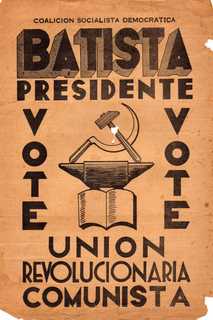
This image is a poster for Fulgencio Bautista, who was put into power in Cuba in 1952. The creator of this poster is unknown, but it was made in support of Bautista and his political party, making it safe to assume the artist is a communist supporter of Bautista. His party, the Union Revolucionaria Communista, now known as the Partido Socialista Popular, is printed on the bottom. It originates from around the 1940s-1950, which Chasteen identifies as the end of the Nationalism period of Latin American history. Cuba seems to lag a few years behind other Latin American countries in regard to mass historical movements: they were one of the last to abolish slavery and declare independence, and their neocolonial period lasted a bit longer than other countries as well.
Batista came to power as a US-backed dictator in a time where the US was heavily involved in Latin America. Following the neocolonialism period, which saw revived foreign influence in the Latin American economy and political sphere, the United States government installed pro-US dictators in my Latin American countries. This was done primarily out of self interest, as the United States wanted to assert their control throughout Latin America due to the Monroe Doctrine and Roosevelt Corollary. Near the end of first half of the twentieth century, when many Latin American countries were already experiencing the wave of nationalism, Cuba still felt strong US control, especially through the rule of Batista. This sparked the strong Cuban nationalist feelings that lead to the Revolution in the late 1950s and the eventual rule of Fidel Castro.
Works Cited:
Nação Mestiça. May 11, 2011. “Cuba: El apoyo comunista al gobierno de Fulgencio Batista” https://nacaomestica.org/blog4/?p=12156
By Shane Wallace
